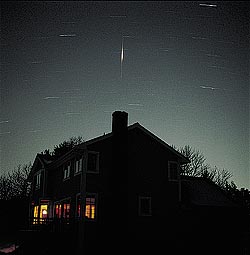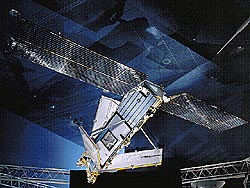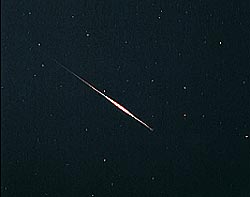
Iridium satellite number 35 lit up the predawn sky west of Boston at 5 a.m. EST on February 1, 1998, as Sky & Telescope senior editor Dennis di Cicco waited with his camera, taking a 10-minute exposure on Fujichrome 100 slide film through an 80-mm f/2.8 Hasselblad lens working at f/4.
Of the roughly 3,000 spacecraft in Earth orbit, nearly 100 stand apart: the Iridium communications spacecraft, which skim the uppermost, most rarefied region of the atmosphere (the exosphere) at altitudes around 800 kilometers in six steeply inclined orbital planes (orbits that nearly pass overhead at the North and South Poles). Known as an iridium flare, the glare from these satellites is well known to many astronomers.
In financial circles, the Iridium "constellation" of satellites stands apart because it was built at a cost of roughly $5 billion, only to be sold for $25 million when its first corporate owner, Iridium LLC, went bankrupt in 1999. The spacecraft (and the ground stations supporting them) were intended to enable owners of special portable telephones to communicate from any point on the surface of the globe. However, Iridium LLC never obtained the millions of customers needed to make the project profitable. The U.S. Department of Defense and Federal Emergency Management Agency are among the principal customers of the satellites' current corporate owner, Iridium Satellite LLC of Leesburg, Virginia.

On the morning of August 8, 2006, an Iridium flare over Golden, Colorado, reached magnitude –3.4. It was captured in real time using a Paramount ME robotic telescope mount, a 5-inch astrograph, and an ultrasensitive video camera. For more information and higher-resolution movie files, visit Tom's Corner on the Software Bisque Web site.
Tom Bisque (Software Bisque)
In skywatching circles, the Iridium satellites stand apart because their flat, shiny, door-size antenna arrays (three per spacecraft) periodically reflect sunlight toward the ground, causing brief (seconds-long) but brilliant flares that can momentarily reach an apparent magnitude of –8 — outshining the planet Venus. What's more, these flares are predictable, thanks to the satellites' publicly available orbital elements and to software and Web sites that satellite-watching aficionados have made available free of charge.
Planning Your Iridium Flare Observation
Most would-be Iridium flare watchers need go no further than Heavens Above. This fascinating Web site is maintained by Chris Peat, a physicist and space-industry veteran who now works for the German Space Operations Center. A few mouse clicks should produce a list of any Iridium flares occurring over your location in the next several days. Each listing will tell you where in the sky to look — and when! — to see sunlight glint off an Iridium spacecraft's antenna panel. The site also will tell you how bright the flare should appear (in magnitudes), and where to go to see that particular flare at its very brightest (traveling just a few kilometers can make a big difference in the flare’s brightness). Note that you can see some Iridium flares in daylight if your skies are very clear and you look in precisely the right direction!

When deployed as intended, an Iridium satellite's spin axis points to the center of the Earth, while three silvered Main Mission Antennas lean outward, peppering Earth with data-bearing radio transmissions and the occasional glint of sunlight. Flares also reportedly may be generated by the satellites' two solar panels. This unit is on display at the National Air and Space Museum in Washington, D.C.
Eric Long / National Air and Space Museum / Smithsonian Institution (SI Neg. No. 2000-8953)
Heavens Above tabulates the altitude and azimuth of each flare event, but you also can use the site to plot a particular flyover against the stars as follows: once you have the list of flares generated by the steps given above, click on a particular spacecraft ("Iridium 53," say), and then on "Passes." This will give you a list of that spacecraft's passes over your location for the next several days. Click on one of those passes by date, and you can get a star chart showing the spacecraft's quickly changing position among the stars.
To explore the Iridium-flare phenomenon in more detail, check out the Visual Satellite Observer's Home Page, whose Iridium section provides links to orbital elements, aficionados' custom flare-predicting software, and other resources. More information — launch history; financial and political developments — on the Iridium satellite constellation (and others) is available on a Web site maintained by University of Surrey (U.K.) communications specialist Lloyd Wood.
A Blessing or a Curse?

Imelda Joson and Edwin Aguirre timed this 30-second exposure to capture Iridium satellite number 52 as it generated a magnitude –8 flare — about as bright as they get — as seen from a suburb northwest of Boston. Their January 14, 2003, photo on Kodak Royal Gold 400 film was taken with a 70-mm lens at f/4.
Imelda B. Joson / Edwin L. Aguirre
Once smitten by the Iridium flare bug, you may want to capture flares on film, video, or with a digital camera. Astrophotographer and Sky & Telescope editor Dennis di Cicco's advice for capturing iridium flares with astrophotography are simple enough for many levels of astronomer. You can get more advice from (and share your results with!) the Internet-based SeeSat-L discussion group, which meets in cyberspace here.
Whether the Iridium flares are a blessing or a curse is a matter of perspective. Apart from their beauty and drama, their predictability makes them a great teaching tool for astronomers seeking to draw the eyes of the public skyward. But along with myriad other communications satellites (to say nothing of the International Space Station), some stargazers deem Iridium flares roving light-pollution sources that contaminate sky photographs and destroy what should be a purely natural experience of the night sky. Radio astronomers have found their observations of interstellar hydroxyl (OH) compromised (and sometimes wholly precluded) by interference from the Iridium spacecraft, which transmit at frequencies that are very close to a critical band reserved by international law for scientific use.
Admired or despised, the Iridium fleet may not be around forever. In order to minimize their contribution to the ever-growing population of "space junk" in low-Earth orbit, the systems’s owners are expected by the U.S. government to bring down any spacecraft that no longer function as part of the Iridium communications network.
In February 2009, the satellite Iridium 33 collided with a defunct Russian satellite over Siberia, and thousands of pieces of debris from that smashup will linger in orbit for many years to go.
 0
0








Comments
You must be logged in to post a comment.